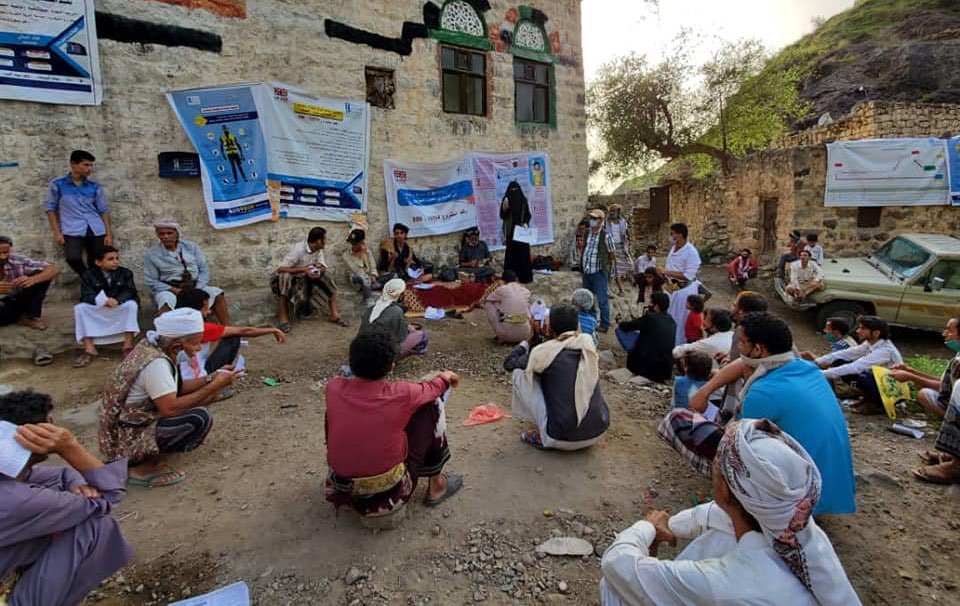The day-to-day hardships of the COVID-19 pandemic are often compared to life during wartime. But Yemenis have it far worse: They are experiencing a pandemic and a war simultaneously. Before 2020, Yemen’s ongoing civil war had cut GDP almost by half; since then COVID-19 has further decimated the economy. Dalia Elsabbagh, Sikandra Kurdi, and Manfred Wiebelt find that a major cause is a plunge in remittances from abroad, which has hurt both incomes and employment across the country.—Johan Swinnen, series co-editor and IFPRI Director General.
Even before the COVID-19 pandemic battered economies across the world, Yemen had already experienced a half decade of civil war, resulting in a loss of approximately 45% of its real GDP by the end of 2019, according to the Yemeni Ministry of Planning. As the conflict continued, remittances from Yemenis working outside the country kept many households afloat and became an increasingly important source of income, estimated at $3.77 billion in 2019—around 13% of GDP.
But with the spread of COVID-19 in 2020, the flow of remittances dramatically shrank. The incomes of Yemenis working in Gulf states, the United Kingdom and the United States plummeted due to low oil prices, lockdowns and other social distancing measures in host countries. Transfers into Yemen through one major remittance service, Alkuraimi Islamic bank, reportedly dropped by 70% in March 2020. Data collected from interviews with foreign exchange agents in late 2020 confirm remittances remained low through the year.
How has this major income loss affected Yemen’s beleaguered economy? We modeled the impacts using a Social Accounting Matrix (SAM) multiplier model approach, showing that the falloff in remittances led to significant declines in household income that hit the poor the hardest, as well as significant indirect effects on production, food systems, and employment.
Impact on household income
While the model shows all Yemeni households experiencing an income loss in 2020 due to COVID-19, the impacts are regressive, with poorer households experiencing proportionally larger declines.
Overall, the model shows the poorest households, represented by quintiles 1 and 2, suffering a severe income loss of approximately 21% over the year 2020 (Figure 1) due mainly to their high income dependency on remittances. Higher income quintiles experience a less significant share of income loss, while absolute income losses are larger.
Rural households experience slightly higher income losses than urban households, as the former are among the poorer segments of Yemeni society, with higher shares of remittance income, as well as having a larger share of earned income from agriculture and services, which were more heavily affected by lower household consumption nationally.
In addition to directly reducing households’ disposable income for consumption, the resulting decrease in demand has indirect effects on the wider economy. A comparison of total household income changes with direct changes resulting from remittances (Figure 1) shows that these indirect effects generally add another 2 to 3 percentage points to income losses—resulting from the contraction of the agriculture, industry, and services sectors.
Impacts on GDP by sector
On the country level, the model estimates the drop in remittances caused a decline of 8.5% in Yemen’s real GDP for 2020. The impacts on the economy are fairly evenly distributed across sectors: Agriculture is estimated to decline by more than 9% and industry and service sectors by more than 8%. The agriculture sector, industry, and services sectors represent 19%, 20%, and 61% of the Yemeni GDP in 2019, respectively. So, while the agricultural sector is the most affected in percentage terms, the largest absolute decline appears in the services sector.
The agrifood system as a whole declines by 9.5%. While all food sectors are affected, the greatest economic damage occurs in food processing, including grain milling and coffee processing, with estimated losses of 9.7%, explained by the lower household demand.
Impact on employment
The impact of the pandemic-induced decline in remittances on employment is mainly driven by job losses in the services sector, which employs 60% of all workers (according to the SAM), followed by agriculture, which experienced the largest relative decline (Figure 2). Within the service sector, trade and transport experience a sharp fall in demand caused by the contraction in almost all value chains. Decreased demand for business and health services and real estate activities, for household workers, and in construction, and agriculture also contributed significantly to the decline in employment.

As the war continued through 2020, Yemen implemented few direct large-scale pandemic mitigation measures. Clearly, however, our SAM multiplier modeling results show a sizeable adverse short-term impact on economic output and household welfare from lost remittances that even robust pandemic responses from the Yemeni government would do little to address. The longer-term economic impact will depend on the pandemic responses of neighboring Gulf countries—allowing remittances to recover—and on maintaining or increasing foreign aid flows that serve as the other key source of crisis support to Yemeni household incomes, during a time when foreign aid budgets face unusual pandemic-related pressures.
Dalia Elsabbagh is a Senior Research Assistant in IFPRI’s Egypt Strategy Support Program (ESSP), based in Cairo; Sikandra Kurdi is a Research Fellow with IFPRI’s Development Strategy and Governance Division, working with ESSP; Manfred Wiebelt is a Senior Research Fellow and Professor of Economics (emeritus) at the Kiel Institute for the World Economy, Kiel, Germany. The analysis and opinions expressed in this piece are solely those of the authors.
Funding for this study was provided by the International Fund for Agricultural Development (IFAD) under the Agriculture Investment Data Analyzer (AIDA) project and the IFPRI-led CGIAR Research Program on Policies, Institutions, and Markets (PIM).







